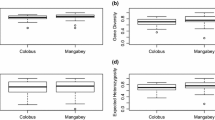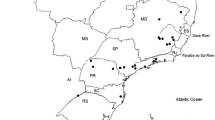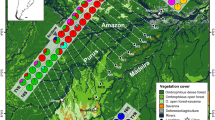Abstract
We used mtDNA sequence data from the Tana River red colobus and mangabey to determine how their population genetic structure was influenced by dispersal and habitat fragmentation. The colobus and mangabey are critically endangered primates endemic to gallery forests in eastern Kenya. The forests are a Pliocene–Pleistocene refugium that has recently undergone significant habitat loss and fragmentation due to human activities. We expected both primates to exhibit low levels of genetic diversity due to elevated genetic drift in their small populations, and to show a strong correspondence between genetic and geographic distance due to disruption of gene flow between forests by habitat fragmentation. Additionally, because mangabey females are philopatric, we expected their mtDNA variation to be homogeneous within forest patches but to be heterogeneous between patches. In contrast, colobus have a female-biased dispersal and so we expected their mtDNA variation to be homogeneous within and between forest patches. We found high levels of haplotype and nucleotide diversity as well as high levels of sequence divergence between haplotype groups in both species. The red colobus had significantly higher genetic variation than the mangabey did. Most of the genetic variation in both primates was found within forest fragments. Although both species showed strong inter-forest patch genetic structure we found no correspondence between genetic and geographic distances for the two primates. We attributed the high genetic diversity to recent high effective population size, and high sequence divergence and strong genetic structures to long-term habitat changes in the landscape.




Similar content being viewed by others
References
Andrews P, Groves CP, Horne JFM (1975) Ecology of the lower Tana River floodplain (Kenya). J East Afr Nat Hist Soc Natl Mus 151:1–31
Avise JC, Arnold J, Ball RM, Bermingham E, Lamb T, Neigel JE, Reeb CA, Saunders NC (1987) Intraspecific phylogeography—the mitochondrial-DNA bridge between population genetics and systematics. Annu Rev Ecol Syst 18:489–522
Bobe R, Behrensmeyer AK (2004) The expansion of grassland ecosystems in Africa in relation to mammalian evolution and the origin of the genus Homo. Palaeogeogr Palaeoclimatol Palaeoecol 207:399–420
Brown WM, George M, Wilson AC (1979) Rapid evolution of animal mitochondrial-DNA. Proc Natl Acad Sci USA 76:1967–1971
Butynski TM, Mwangi G (1994) Conservation status and distribution of the Tana River red colobus and crested mangabey for Zoo Atlanta, Kenya Wildlife Service, National Museums of Kenya, Institute of Primate Research, and East African Wildlife Society 68 p
Casgrain P, Legendre P, Vaudor A (2005) The R Package for multivariate and spatial analysis version 4.0. Département de sciences biologiques, Université de Montréal, Canada
Collura RV, Stewart CB (1995) Insertions and duplications of mtDNA in the nuclear genomes of old world monkeys and hominoids. Nature 378:485–489
deMenocal PB (2004) African climate change and faunal evolution during the Pliocene-Pleistocene. Earth Planet Sci Lett 220:3–24
Dinerstein E, McCracken GF (1990) Endangered greater one-horned rhinoceros carry high-levels of genetic-variation. Conserv Biol 4:417–422
Dittus WPJ (1988) Group fission among wild toque macaques as a consequence of female resource competition and environmental stress. Anim Behav 36:1626–1645
Dowling TE, Moritz C, Palmer JD (1990) Nucleic acids II: restriction site analysis. In: Hillis D, Moritz C (eds) Molecular systematics. Sinauer Press, Sunderland, MA, pp 250–317
Excoffier L, Smouse PE, Quattro JM (1992) Analysis of molecular variance inferred from metric distances among DNA haplotypes—application to human mitochondrial-DNA restriction data. Genetics 131:479–491
Excoffier L, Laval G, Schneider S (2005) Arlequin ver. 3.0: an integrated software package for population genetics data analysis. Evol Bioinform Online 1:47–50
Fleagle JG (1999) Primate adaptations and evolution, 2nd edn. Academic Press, New York
Grubb P, Butynski TM, Oates JF, Bearder SK, Disotell TR, Groves CP, Struhsaker TT (2003) Assessment of the diversity of African primates. Int J Primatol 24:1301–1357
Gyllensten U, Wharton D, Wilson AC (1985) Maternal inheritance of mitochondrial-DNA during backcrossing of 2 species of mice. J Hered 76:321–324
Hamilton AC (1981) The quaternary history of African forests—its relevance to conservation. Afr J Ecol 19:1–6
Hapke A, Zinner D, Zischler H (2001) Mitochondrial DNA variation in Eritrean hamadryas baboons (Papio hamadryas hamadryas): life history influences population genetic structure. Behav Ecol Sociobiol 50:483–492
Harpending HC (1994) Signature of ancient population-growth in a low-resolution mitochondrial-DNA mismatch distribution. Hum Biol 66:591–600
Hayashi JI, Tagashira Y, Yoshida MC (1985) Absence of extensive recombination between interspecies and intraspecies mitochondrial-DNA in mammalian-cells. Exp Cell Res 160:387–395
Heller R, Lorenzen ED, Okello JB, Masembe C, Siegismund HR (2008) Midholocene decline in African buffalos inferred from Bayesian coalescent-based analyses of microsatellites and mitochondrial DNA. Mol Ecol 17:4845–4858
Hewitt G (2000) The genetic legacy of the quaternary ice ages. Nature 405:907–913
Hilton-Taylor C (2000) IUCN Red List of threatened species. IUCN, Morges, Swit
Hughes FMR (1990) The influence of flooding regimes on forest distribution and composition in the Tana River floodplain, Kenya. J Appl Ecol 27:475–491
Kimura M, Weiss GH (1964) Stepping stone model of population structure and the decrease of genetic correlation with distance. Genetics 49:561–576
Kinnaird MF (1992) Variable resource defense by the Tana River crested mangabey. Behav Ecol Sociobiol 31:115–122
Kumar S, Tamura K, Nei M (2004) MEGA3.1: integrated software for molecular evolutionary genetics analysis and sequence alignment. Brief Bioinform 5:150–163
Liu Z, Ren B, Wei F, Long Y, Hao Y, Li M (2007) Phylogeography and population structure of the Yunnan snub-nosed monkey (Rhinopithecus bieti) inferred from mitochondrial control region DNA sequence analysis. Mol Ecol 16:3334–3349
Livingstone DA (1975) Late quaternary climatic change in Africa. Annu Rev Ecol Syst 6:249–280
Mace GM, Balmford A (2000) Patterns and processes in contemporary mammalian extinction. In: Entwhistle A, Dunstone N (eds) Priorities for the conservation of mammalian diversity: has the panda had its day?. Cambridge University Press, Cambridge, pp 27–52
Mantel N (1967) The detection of disease clustering and a generalized regression approach. Cancer Res 27:209–220
Marsh CW (1979) Female transference and mate choice among Tana River red colobus. Nature 281:568–569
Marsh CW (1981) Ranging behavior and its relation to diet selection in Tana River red colobus (Colobus-badius-ruformitratus). J Zool 195:473–492
Mbora DNM, Meikle DB (2004) Forest fragmentation and the distribution, abundance and conservation of the Tana River Red Colobus (Procolobus rufomitratus). Biol Conserv 118:67–77
Medley KE (1992) Patterns of forest diversity along the Tana River, Kenya. J Trop Ecol 8:353–371
Melnick DJ, Hoelzer GA (1992) Differences in male and female macaque dispersal lead to contrasting distributions of nuclear and mitochondrial-DNA variation. Int J Primatol 13:379–393
Melnick DJ, Hoelzer GA (1996) The population genetic consequences of macaque social organization and behaviour. In: Fa JE, Lindburg DG (eds) Evolution and ecology of macaque societies. Cambridge University Press, Cambridge, pp 413–443
Melnick DJ, Kidd KK (1983) The genetic consequences of social group fission in a wild population of rhesus monkeys (Macaca mulatta). Behav Ecol Sociobiol 12:229–236
Mittermeier RA, Ratsimbazafy J, Rylands AB, Williamson L, Oates JF, Mbora DNM, Ganzhorn JU, Rodríguez-Luna ER, Palacios E, Heymann EW, Kierulff MCM, Yongcheng L, Supriatna J, Roos C, Walker S, Aguiar JM (2007) Primates in peril: the world’s 25 most endangered primates, 2006–2008. Primate Conserv 22:1–40
Myers N, Mittermeier RA, Mittermeier CG, da Fonseca GAB, Kent J (2000) Biodiversity hotspots for conservation priorities. Nature 403:853–858
Nei M (1987) Molecular evolutionary genetics. Columbia University Press, New York
Nsubuga AM, Robbins MM, Roeder AD, Morin PA, Boesch C, Vigilant L (2004) Factors affecting the amount of genomic DNA extracted from ape faeces and the identification of an improved sample storage method. Mol Ecol 13:2089–2094
Okello JBA, Nyakaana S, Masembe C, Siegismund HR, Arctander P (2005) Mitochondrial DNA variation of the common hippopotamus: evidence for a recent population expansion. Heredity 95:206–215
Okello JBA, Wittemyer G, Rasmussen HB, Arctander P, Nyakaana S, Douglas-Hamilton I, Siegismund HR (2008) Effective population size dynamics reveal impacts of historic climatic events and recent anthropogenic pressure in African elephants. Mol Ecol 17:3788–3799
Posada D, Crandall KA (1998) MODELTEST: testing the model of DNA substitution. Bioinformatics 14:817–818
Rogers A (1995) Genetic evidence for a Pleistocene population explosion. Evolution 49:608–615
Rozas J, Sánchez-DelBarrio JC, Messeguer X, Rozas R (2003) DnaSP, DNA polymorphism analyses by the coalescent and other methods. Bioinformatics 19:2496–2497
Shimada MK (2000) Geographic distribution of mitochondrial DNA variations among grivet (Cercopithecus aethiops aethiops) populations in central Ethiopia. Int J Primatol 21:113–129
Storz JF, Beaumont MA (2002) Testing for genetic evidence of population expansion and contraction: an empirical analysis of microsatellite DNA variation using a hierarchical Bayesian model. Evolution 56:154–166
Storz JF, Ramakrishnan U, Alberts SC (2002) Genetic effective size of a wild primate population: influence of current and historical demography. Evolution 56:817–829
Taberlet P, Meyer A, Bouvet J (1992) Unusual mitochondrial DNA polymorphisms in two local populations of blue tit Parus caeruleus. Mol Ecol 1:27–36
Thalmann O, Hebler J, Poinar HN, Paabo S, Vigilant L (2004) Unreliable mtDNA data due to nuclear insertions: a cautionary tale from analysis of humans and other great apes. Mol Ecol 13:321–335
Vigilant L, Stoneking M, Harpending H, Hawkes K, Wilson AC (1991) African population and the evolution of human mitochondrial DNA. Science 253:1503–1507
Weir BS, Cockerham CC (1984) Estimating F-statistics for the analysis of population structure. Evolution 38:1358–1370
Whitlock MC, McCauley DE (1990) Some population genetic consequences of colony formation and extinction: genetic correlations within founding groups. Evolution 44:1717–1724
Wimmer B, Tautz D, Kappeler PM (2002) The genetic population structure of the gray mouse lemur (Microcebus murinus), a basal primate from Madagascar. Behav Ecol Sociobiol 52:166–175
World Bank (1996) The Republic of Kenya: Tana River primate national reserve. Project document. The World Bank, Washington, DC
Wright S (1978) Evolution and the genetics of populations. Volume 4. Variability within and among natural populations. University of Chicago Press, Chicago
Zhang DX, Hewitt GM (1996) Nuclear integrations challenges for mitochondrial DNA markers. Trends Ecol Evol 11:247–251
Acknowledgments
We are grateful to our dedicated field assistants; Abio Gafo, Michael Morowa, John Kokani, Sylvia Isaya, Mary Galana, Hiribae Galana, Galana Galole, Bakari Kawa, and Mohamed Kawa. And, for additional field assistance from Drs. Julie and Gerard Wieczkowski. We are indebted to our professional colleagues who helped at various stages of the project. We are grateful for tissue samples from Dr. Cathi Lehn (Colobus guereza) and Dr. Nelson Ting (Procolobus tephrosceles and Procolobus badius) and genomic DNA from Dr. TL Goldberg (Procolobus tephrosceles). Drs. Cathi Lehn, Ryan Thum and Nelson Ting offered useful advice on technical procedures. Drs. Douglas Meikle and Douglas Bolger offered critical comments on early drafts of the manuscript, and the comments of two anonymous reviewers are greatly appreciated. Funding of this work came from The Rufford Foundation, Margot Marsh Biodiversity Foundation, National Geographic Society, and Dartmouth College. Permission to conduct research was granted by the government of Kenya via permit number: MOEST13/001/35C417/2.
Author information
Authors and Affiliations
Corresponding author
Rights and permissions
About this article
Cite this article
Mbora, D.N.M., McPeek, M.A. Endangered species in small habitat patches can possess high genetic diversity: the case of the Tana River red colobus and mangabey. Conserv Genet 11, 1725–1735 (2010). https://doi.org/10.1007/s10592-010-0065-0
Received:
Accepted:
Published:
Issue Date:
DOI: https://doi.org/10.1007/s10592-010-0065-0




